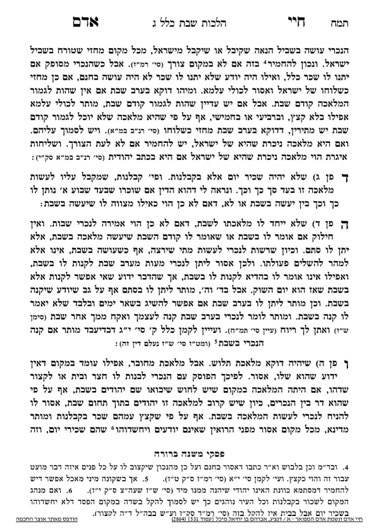We are continuing in siman 6, where the Chayei Adam discusses the fifth criterion for it to be permitted to make an arrangement with a non-Jew before Shabbos regarding melacha on Shabbos. The Chayei Adam writes that the item which the non-Jew will be working on must be talush, detached from the ground. If the item is mechubar, attached to the ground, whether agricultural or construction, it is assur.
We learned from the Piskei Mishnah Berurah that if it is known that this specific type of work is always done through a kablan arrangement, it will be muttar (assuming the other criteria we have been discussing are met). We left off that the Mishnah Berurah holds one can rely on this idea when it comes to agricultural work, but not regarding construction. This is based on a Biur Halacha, in siman 244, where he brings multiple rishonim who hold that a case of construction is always going to be assur, but that there is a difference between agriculture and construction. Today, we will clarify this difference.
There is a machlokes rishonim regarding the chashad over here.
- The primary understanding is the concern that people will think the non-Jew was hired as a sechir yom rather than as a kablan, as we have mentioned. However, there are other understandings.
- Rashi says that the concern is that even if people assume the arrangement is one of a kablan, people may think the arrangement was made on Shabbos itself rather than before Shabbos.
- The Baal Hamaor understands the concern is that people will not understand the halachic difference between a kablan and sechir yom, and mistakenly think that just like a kablan arrangement is muttar, a sechir yom arrangement is muttar as well.
- Some understand, based on the Rambam, that the concern is that people will think the Jew specifically designated that the work be done on Shabbos (see S0073).
- The Chayei Adam will say later that he understands the concern is that people will think the Jew is benefitting from the work the non-Jew is doing, both in terms of the time gained and that there is some sort of financial gain for the Jew.
The rishonim also discuss the significance of the chashad.
- The simple understanding is that Chazal did not want people to think that Jews do aveiros. If Reuvein sees a non-Jew working on Shimon’s property, he will think Shimon is doing an aveira. There are other explanations as well.
- Some understand that the chashad is a bizayon of Shabbos, that people do not respect Shabbos properly. This, in turn, will cause others to disrespect Shabbos as well.
- A third explanation is the concern that people will misunderstand the halachic nuances that make a case of kablan muttar, and think that other cases are muttar as well.
We will not get involved in the difference between agriculture and construction, but we see that the concern for chashad runs deep. It is important to note that Rav Akiva Eiger is lenient even regarding construction in a case of a monetary loss, so if one has such a question, they should discuss it with their rav.
Summary
- If one instructs a non-Jew before Shabbos, there are times when it will be muttar, depending on eight conditions.
- The fifth condition is that the item not be attached to the ground, due to a concern of maris ayin.
- However, if the maris ayin is not relevant, such as in a place where Jews have no access on Shabbos, or the Jews around have no reason to suspect anything assur, it is not a problem. One should discuss such a question with their rav.



